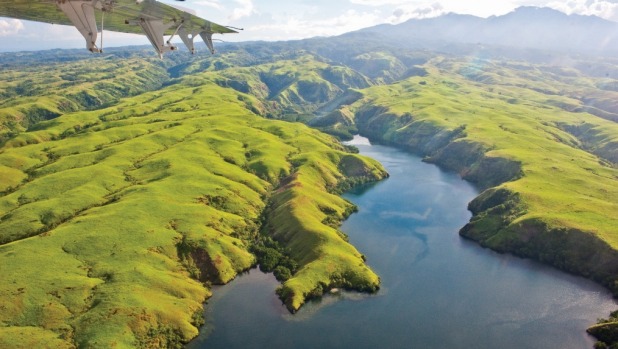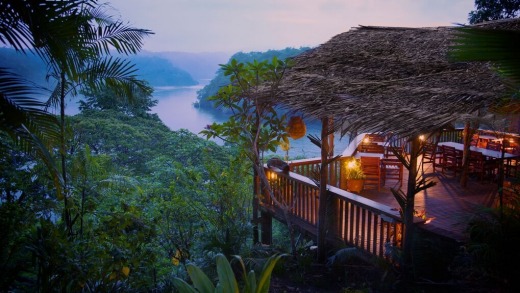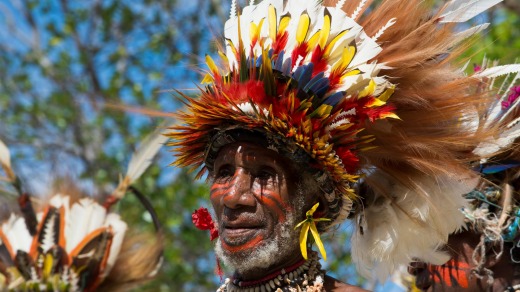
The moment we enter the sun-dappled jungle clearing, I realise we have got the dress code wrong. For this rumble in the jungle – actually a friendly get-together with some members of the local tribe – our small group of travellers is clad in a motley selection of T-shirts, shorts and sarongs.
Our hosts have taken a different approach. The first figure to stride towards us, a smile of welcome on his face, introduces himself as Virgil. Virgil is looking sharp. Long fronds of green grass wrap around his shins, tucking into the waistband of the tapa cloth that hangs between his legs. Thick clumps of grass are tied around his biceps, along with plumes of red and orange blossoms. Shell necklaces lie on his chest in a profusion that brings to mind Ali G.
It is an impressive effort, and he hasn't even put on his headdress yet.

Virgil is not the only one who has frocked up. Several dozen tribespeople have come to meet us today, all in their party best. Later, we will have the opportunity for in-depth chats about their wardrobe; first, however, we have the official welcome.
Make that welcomes, plural. There are two ways visitors to these parts have traditionally been greeted. Unannounced visitors would find black-painted warriors leaping at them out of the undergrowth, brandishing spears and issuing challenges – an experience which we also undergo. Although we know this is merely a demonstration, the fierce interrogation is definitely intimidating.
Shoals of fish dart between the coral branches and we spot clams and nudibranch, gobies and anemones.
Having established our credentials as invited guests, we are then treated to a friendlier welcome, with shouts of "Oro!" – "welcome" – and flowers raining down on us. This is more like it.

It is a colourful introduction to PNG's complex tribal cultures. On this jungle excursion, we learn about everything from grooming - watching demonstrations of facial tattooing, traditionally a sign of female beauty in this area – to daily tasks like preparing meals. We watch locals harvesting sago, a staple food, a time-consuming process in which the fibres are hacked out of a log and repeatedly rinsed and squeezed dry. The resulting, rather spongy mass is wrapped in leaves and heated over a fire, to emerge as a chewy, surprisingly pleasant-tasting loaf, a bit like bread with a blackened crust.
The highlight of the day is the sing sing ceremony, filled with vibrant songs and dances. With their ornate headdresses on, pounding on drums as they chant and stomp, Virgil and his mates are an imposing sight. The drums are far from simple instruments: thanks to little knobs of beeswax on the lizard-skin drum head, which function as precise tuning devices, a surprisingly broad range of sounds ensues.
What really captures our attention, however, are the headdresses. These magnificent constructions are dense with colourful feathers jutting skywards, red and white and black and yellow. Making a headdress is one of the first tasks that a man undertakes on coming of age, and is a long-term undertaking: each man has to comb the forest on his own to find the feathers that will decorate his headpiece. Like our hosts today, most of PNG's population still follows traditional lifestyles. Virgil tells me about his family, most of whom remain subsistence farmers. Of his 10 siblings, only three - Virgil included - have completed high school. Two of his siblings are teachers; another is the local policeman; while Virgil himself works with those few tourists who come to the area.
After the sing sing, our hosts load us into their long, sleek canoes and paddle down the river to the inlet where our launch awaits. Boats are essential transport here in Tufi, a remote spot on the east coast of the Papuan peninsula. There are no roads, so locals either follow the walking tracks through the jungle or jump in a boat.
There are two particularly remarkable things about Tufi. One is the verdant tropical fjords that crenellate its coastline. Technically, these are rias, not fjords - carved by volcanoes, unlike fjords, which are carved by ice – but the long, jungle-covered fingers of land stretching into the sea are eye-catching, nonetheless.
Tufi's other great wonder lurks beneath the water. The coral reefs here include some of the best in the South Pacific. Snorkelling at Cyclone Reef, we enjoy perfect visibility as we swim over fields of coral in a bewildering array of colours and shapes. Shoals of fish dart between the coral branches and we spot clams and nudibranch, gobies and anemones. A trio of divers pass us as they descend: this bommie sinks down 600 metres, and sightings of tuna, shark and turtles are common.
Tufi's one resort – prosaically called Tufi Resort – offers 26 comfortable cabins and a full range of marine activities, including fishing, and excellent food. (Local lobster often appears on the dinner table.) More than just accommodation, however, it offers a lifeline to the surrounding villagers, bringing jobs and visitors to a largely neglected area. At a time when local air strips across the country are closing down, the resort provides a reason to keep Tufi's air strip open.
"An air strip is vital to a community like this," says the resort's co-owner, Linda Honey. "It doesn't just affect tourism, it affects agriculture; it means locals are able to create their own businesses, and sell the produce that they grow."
Honey and her husband have worked with local villages to create cultural tours that offer insights for visitors and income for locals. We visit several villages during our stay, and are always welcomed warmly. The villages tend to be simple – huts with woven walls and roofs of palm fronds – but every house is surrounded by a well-tended garden. The huts are ranged loosely around a central, immaculately kept village green which is particularly impressive given that the absence of lawnmowers requires the landscaping to be done with machetes.
There is no electricity, and villagers dig their own wells to get water. When a drought comes – there is one at present – they may have to walk up to two hours to get water. Without industry to offer jobs, the locals survive by growing sago, bananas, pineapples and, above all, taro – along with fish, the staple diet. Occasionally, a cassowary or wild boar speared in the jungle provides a feast.
Children attend the local schools, where they learn basic English. Few make it to high school in the nearest city, Popondetta, a six-hour boat ride away. Those who do finish their education have a big impact on their communities: many stay in town and get jobs, sending money home to their parents, which is spent on such "luxuries" as outboard motors for their small boats.
We encounter plenty of local entrepreneurs, from the women selling woven bilims to villagers like Paul, who has created a beautiful butterfly garden overlooking the fjords by planting shrubs known to attract the pretty insects. A number of the villages now offer simple guesthouses for overnight stays, which can be organised through Tufi Resort.
Orotoaba is a popular choice with birders keen to spot birds of paradise. The biggest village in the area, Orotoaba has a sense of its own dignity. Through the centre of the village, the locals have planted a double row of palms to form a tropical Champs Elysees.
One evening back at the resort, a local string band delivers South Pacific style covers of songs such as Simon & Garfunkel's Cecilia. I recognise one of the performers: Virgil's brother Franklin, the local policeman. Unlike Virgil, whose taste in music is strictly traditional, Franklin developed a love for the blues by listening to his battery-operated radio.
Franklin introduces me to the rest of the group, which includes another brother, Elvis, and a handful of offspring: a young Virgil, Junior Frank, Little Elvis and – delightfully – Priscilla. Despite their isolation, the villagers' names are a sure sign that they are not completely cut off from the wider world, a fact we discover during one walk in the jungle. We run into a small girl playing by herself in the river, who greeted us with a dazzling smile. When we ask her name, she announces proudly, "Beyonce!"
MORE INFORMATION
papuanewguinea.travel/australia
GETTING THERE
Air Niugini operates 27 direct flights weekly from Australia to Papua New Guinea from Cairns, Brisbane and Sydney, as well as a code share with Qantas. airniugini.com.pg. Domestic carrier Airlines PNG flies from Port Moresby to Tufi three times a week. apng.com
STAYING THERE
Tufi Resort offers year-round diving and cultural experiences. Packages start from $750 for five nights including accommodation, meals and airport transfers at Tufi. tufiresort.com
MORE PNG HIGHLIGHTS
Madang This coastal town may be a faded beauty but it offers great diving, with lovely coral gardens and plenty of wreck dives. The hills above town are also a good place to spot birds of paradise.
Trobriand Islands Several expedition cruises include the Trobriand Islands on their itineraries, for their unique matrilineal culture, their exquisite carvings and their lovely yam houses.
Kokoda Trail There are no creature comforts on this gruelling 10-day trek through the Owen Stanley Ranges, with trekkers sleeping in simple jungle camps.
The Highlands With peaks soaring to heights of 4000 metres, and hundreds of different tribal cultures, the Highlands are one of PNG's most fascinating regions. Goroka makes a good base, and gives you easy access to Asaro, the village where the famous mud men come from.
Vanimo Surfers looking for an uncrowded break should head for Vanimo, PNG's nascent surfing hot spot. There are half a dozen breaks to choose from, and the surf is consistent during the monsoon season, October through to April.